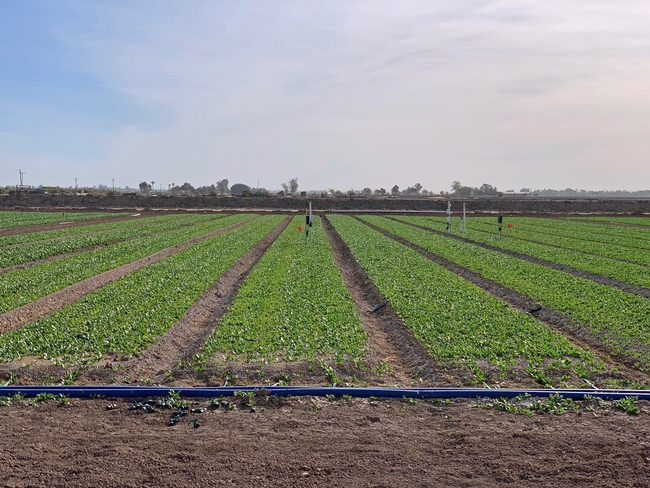
Posts Tagged: drip irrigation
Drip irrigation continues to yield benefits
Considered among the most important agricultural innovations in the world, drip irrigation has been researched for decades. UC Cooperative Extension weed management advisor Aliasghar Montazar has taken a close look at its application in organic spinach cultivation, reported Matthew Grassi in Growing Produce.
Not only does drip irrigation use less water than irrigation with sprinklers, the slow emission of water near plant roots also diminishes the crops' susceptibility to disease. Growers believe that ongoing issues with downy mildew is at least partially caused by moisture that sprinklers leave in the plant canopy.
“Being certified organic, there is really nothing they can use as fungicide; so it is a big problem,” Montazar said. “So, we said ‘Let's try drip (irrigation) in spinach.'”
Early results are promising. Montazar has analyzed enough field data from the plots to directly correlate a four- to five-times reduction in downy mildew disease in plots grown with drip irrigation compared to sprinkler-irrigated plots.
“The other thing to note is there is a nice savings on energy as well,” Montazar said. “Another grower reported he saved $200 an acre on energy savings from getting off the sprinklers. Because with drip, there is less pressure needed, so it consumes less energy (to pump water).”
How does your garden grow? In a drought, consider drip

How does your garden grow?
--English nursery rhyme
How will your garden grow during California’s drought emergency? Gov. Jerry Brown says the state is facing the worst drought in its recorded history.
We urban gardeners may turn quite contrary if our gardens don't grow.
Alternative: Consider installing a drip irrigation system.
Why a drip system? It’s target watering. It’s uniform watering. It’s non-wasteful watering. You don’t want to water the leaves, the space between the plants, or worse, water the sidewalk or let the water gush into the gutter.
Drip irrigation is better for plant health. Plants thrive with drip because it waters them slow and deep where the roots are. You’ll likely minimize weed growth. In comparison to overhead sprinklers, the smaller, targeted area means that weeds will have less opportunity to spring up and try to take over your garden, Gangnam Style. And by not watering the leaves of your plants or allow them to collect standing water, you can reduce diseases.
Drip irrigation is simply a network of pipes, tubing, valves and emitters. Water “drips” or “trickles” directly to the roots.
The concept is not new. Back in the first century, Fan Sheng-Chih Shu wrote about what we now consider a “primitive” drip irrigation system, but one that definitely worked well: Farmers buried perforated unglazed clay pots and filled them with water. They refilled them as needed.
Today’s modern drip irrigation system for urban gardeners includes an irrigation controller with automatic valves or a manual system (shown). If it's automatic, a timer controls the valves and waters the plants while you do something else - like enjoying a glass of lemonade on the back porch, watching your favorite movie, or vacationing in Hawaii. Note: It's a good idea to set your timer for early in the morning, before 8. There's less evaporation.
Of course, there can be disadvantages to the drip system. The key disadvantages are the initial cost of the equipment and labor. Then, too, you must closely monitor the system to ensure the emitters aren’t clogged, or thirsty rodents aren’t gnawing through your plastic pipes.
Find more about drip irrigation on the Sonoma County Master Gardeners website.
Bottom line: A drip irrigation system is often a better alternative to overhead sprinklers or the hand-watering method. Expect to conserve water, save on your water bill, grow healthy plants with fewer weeds and diseases, and save time and effort in doing so.

An artichoke in the drip grid. This area is ready for planting. (Photo by Kathy Keatley Garvey)

A newly planted peach tree among the drip lines. (Photo by Kathy Keatley Garvey)

Corners of the drip grid. (Photo by Kathy Keatley Garvey)

